Patchy Coats
The giraffe is the world’s tallest land mammal and has some curious adaptations to accommodate its lifestyle. The unique patches that wallpaper a giraffe’s body break up its outline and thereby provide camouflage to the animal that has only to stand still to disappear into its surrounds despite its size.
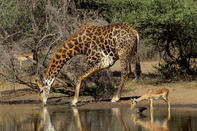
The patches are created by a simple variation in the colour of the fur. Patches darken with age, particularly in males and they vary between individuals, each animal having a unique coat. All animals have mechanisms to thermoregulate (control temperature) and the patches of a giraffe are believed to scatter heat falling on the giraffe’s body.
The general arrangement of patches on giraffe also varies between isolated populations and in spite of some debate there seems to be at least six different recognized races of giraffe in Southern and East Africa.
Are Giraffes Silent?
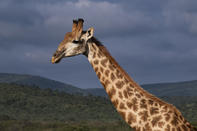
Difference Between the Sexes
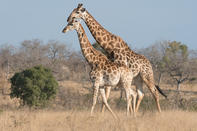
Both sexes of giraffe have horns. In the case of the males, these are stouter and hairless on the top.
Females have more elegant, tufted horns. Males possess ‘a third horn’ known as a median horn in the centre of his forehead. This enlarges over his lifespan as calcification takes place from impacts while necking.
Other calcified knobs also form on the forehead for the same reason. Horns are present right from birth although at the time of birth they are not attached to the skull to assist with an easy exit from the womb. As the calf grows, the cartilage horns ossify onto the skull and become solid bone.
Males are usually darker than females and taller sometimes by a full meter. The penis-sheath of the male breaks the contour of his belly and his large scrotum is obvious.
A Natural Lighthouse
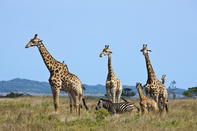
Because of their height advantage and good eyesight, many other animals will associate with giraffe and respond to early signs of danger given by these ‘lighthouses’. Giraffe are also very curious animals and will stare at predators lying in the grass or any other intruder giving shorter animals (and even humans) a clue to the fact that there may be carnivores in an area.
Giraffe do lie down to rest at some point during the night but they generally only sleep curled up in 5-minute instalments as they are very vulnerable during these times.
Big Babies
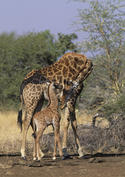
A newborn giraffe weighs 100 kg and can stand in 15 minutes of birth. Although many people believe that the foal’s almost two-metre drop at birth consequently starts their hearts, this is not the case. The foal itself is large and it exits the birth canal head and front feet first (almost spatchcocked).
The cow squats as much as possible and the foal’s feet touch the ground before the rest of the body and hind feet exit, helping it to brace the fall. To start life, the calf spends most of its time lying-up, hidden by its camouflage and propensity to lower its neck if danger threatens.
The mother remains nearby most of the time to keep guard and provide nourishment but she herself may need to find food or drink and so may be absent for hours at a time. Later on youngsters group together in crèches for protection in numbers and to relieve the pressure of individual parents to be on ‘guard duty’. Giraffe manage to stay out of harms way by being large animals with excellent day and night time vision and by possessing a powerful kick.
They are not however immune to predation and some lion prides specialize successfully in hunting giraffe by chasing them over a medium that causes them to trip. Youngsters are vulnerable, which is why they remain concealed for the first part of their lives and until they can run fast enough.
Cows watch over and defend their offspring from harm commendably. Youngsters concentrate most of their food intake on growing out of harms way. A calf grows 1 m in the first six months of its life and doubles that in the first year.
By Megan Emmett